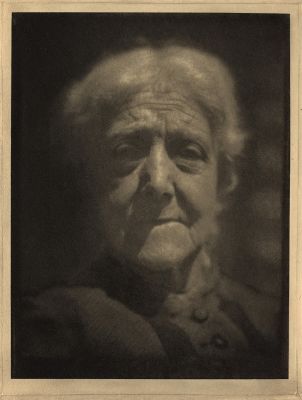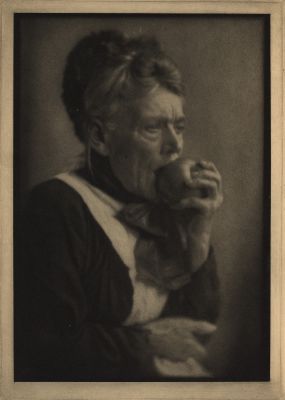
Title
Mrs. StarlingArtist
Hoppe, E.O. (German, 1878-1972)Publication
Taken From LifeDate
1922Process
Photogravure (tissue)Image Size
16 x 12 cm
All but one of these are taken from the lower strata of society, although some of them have achieved relative success in their own world… reads the dust jacket of E.O. Hoppe’s Taken from Life. Hoppé was an early social documentarian who at times leaned towards the soft-focus. The seven richly toned, hand-pulled photogravures in Taken From Life are dark, and stiff, vaguely mysterious. All are studio portraits, with the exception of one. They show underprivileged individuals like a tramp, a cabman, a peddler, a charwoman, and a "drug fiend." Hoppé’s intention was to present these types not as individuals, but as representative of particular groups that he saw vanishing from society. The sympathetic text by J. D. Beresford was a tribute to the fast-disappearing British character of ‘sterling fortitude and quirky individuality’.⠀The use of hand-pulled photogravure may, by some, be considered inappropriate for these typologies (much like Curtis’s North American Indian criticized for using photogravure to romanticize its subject matter.) But what I see is a ‘egalitarian’ treatment of the portraits – offering the subjects an elegance, beauty and dignity typically reserved only for the upper or intellectual classes.
E. O. Hoppé (1878–1972) was one of the most famous photographers of the early 20th century and a leading figure in the modernist movement, described by Cecil Beaton as "The Master". He moved from Germany to Britain as a young man with the intention of training as a financier, but took up photography and quickly became a top celebrity portraitist. He traveled extensively, and his photography encompassed all aspects of life, from images of literary and artistic figures, to the ballets of Diaghilev, industrial and urban scenes in Britain, the US, and Germany, and life in the developing world. Despite his prominence, he is relatively unknown today–in 1954 Hoppé sold his entire archive to a picture library that categorized the images by subject rather than photographer, and his identity vanished from the photographic record. His oeuvre has recently been reclaimed from obscurity and reunited with his letters and biographical documents, leading to a revival of interest in this important photographer.
Reproduced / Exhibited
Fernández, Horacio, and Carlos Ortega. Fotografía Pública: Exposición Organizada Por El Museo Nacional, Centro De Arte Reina Sofía (del 27 De Abril Al 29 De Junio) ; Itinerancia: Museo De Bellas Artes De Bilbao (de Septiembre a Noviembre 1999) ; Centro Cultural La Rioja (de Febrero a Marzo Del 2000). Madrid: Aldeasa, 1999.
References
https://www.eohoppe.com/





